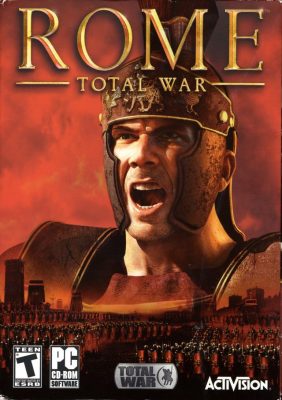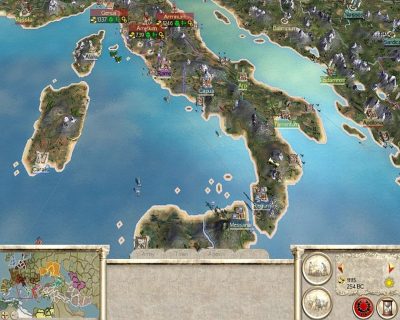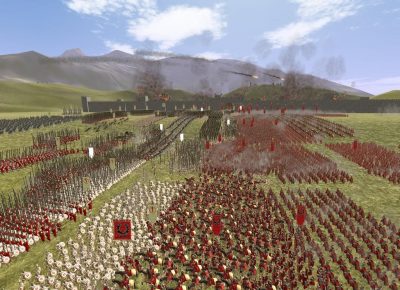Retrospective of Rome: Total War
 “Fortune favors the brave, but victory favors the prepared.” – Publius Cornelius Scipio Africanus
“Fortune favors the brave, but victory favors the prepared.” – Publius Cornelius Scipio Africanus
by Patrick S. Baker
After two hits with Shogun: Total War and Medieval: Total War, the Creative Assembly (CA) Company determined to continue the Total War Series with Rome: Total War (Rome). The team at CA selected the Roman Era for many reasons. It is one of the most popular and well-documented periods in history and offered depth of events, characters, and battles that could be translated into an appealing game.
There was strong interest among gamers for a strategy game set in Roman times. Also, CA’s development team was deeply interested in the time period and thought it would provide a great setting for innovative game-play and a strong strategic narrative.
During the development of both Shogun and Medieval the CA team consulted with notable historians to maintain historical accuracy. While working on Rome, the CA team did a similar level of consultation.
One of the notable historians they consulted was Adrian Goldsworthy. Goldsworthy provided insights into Roman military tactics, the political landscape, and other aspects of Roman life to help create a more authentic experience. CA also referred to historical texts and sources to supplement their understanding of the period. However, despite these consultations, they made some creative adjustments for the sake of game-play. At the tactical level the game is very accurate, but at the strategic level; not so much.
 Published by Activision and released in September 2004, the new game had a number of improvements from Medieval.
Published by Activision and released in September 2004, the new game had a number of improvements from Medieval.
Graphics and Visuals: Rome introduced fully 3D graphics to the Total War games, allowing for a fully 3D campaign map and battle-space. Given the player a more immersive and interactive experience then allowed by the 2D graphics of Medieval.
 The 3D battle engine was so impressive that the History Channel and the BBC used it on two TV series. The first was “Decisive Battles”, a 2004 American animated documentary television series that aired on the History Channel used the game engine from Rome. The show, hosted by Matthew Settle, depicted historic conflicts present 3-D simulations of the battles.
The 3D battle engine was so impressive that the History Channel and the BBC used it on two TV series. The first was “Decisive Battles”, a 2004 American animated documentary television series that aired on the History Channel used the game engine from Rome. The show, hosted by Matthew Settle, depicted historic conflicts present 3-D simulations of the battles.
This innovative approach allowed viewers to witness ancient battles with a level of detail and realism that traditional re-enactments could not achieve. By leveraging Rome’s game engine, the series provided a god’s-eye view of each battle, illustrating how force size, positions, movement, and terrain influenced the outcomes. This blend of gaming technology and historical storytelling made “Decisive Battles” unique.
 The other TV show that used the engine was “Time Commanders”, a British television series that originally aired on BBC Two from 2003 to 2005, with a revival in 2016 on BBC Four. The show featured teams of contestants who re-enacted historical battles using a modified version of the the Rome game engine. Hosted by Eddie Mair, Richard Hammond, and later Gregg Wallace, the series combined elements of a game show with historical education. Contestants, often unfamiliar with computer games, were tasked with developing strategies and commanding forces in famous battles, while military experts analyzed their performance and provided historical context.
The other TV show that used the engine was “Time Commanders”, a British television series that originally aired on BBC Two from 2003 to 2005, with a revival in 2016 on BBC Four. The show featured teams of contestants who re-enacted historical battles using a modified version of the the Rome game engine. Hosted by Eddie Mair, Richard Hammond, and later Gregg Wallace, the series combined elements of a game show with historical education. Contestants, often unfamiliar with computer games, were tasked with developing strategies and commanding forces in famous battles, while military experts analyzed their performance and provided historical context.
Battle Mechanics: Rome introduced more advanced battle mechanics, including the ability to control individual units more precisely and the introduction of new unit types and formations such as the legions being able to form the “testudo”, or tortoise formation. Further, in sieges, while Medieval had basic siege mechanics, Rome enlarged on this with more complex and realistic siege battles, including the use of siege equipment like battering rams and siege towers.
 Faction Diversity: Rome featured a greater diversity of factions, each with unique units and abilities, adding more variety and re-playability to the game. The game starts with three playable Roman factions: the Julii, Brutii, and Scipii. Once the player completes a campaign with any of these factions, they unlock seven additional factions which include the Carthaginians, the Seleucids, and the Parthians.
Faction Diversity: Rome featured a greater diversity of factions, each with unique units and abilities, adding more variety and re-playability to the game. The game starts with three playable Roman factions: the Julii, Brutii, and Scipii. Once the player completes a campaign with any of these factions, they unlock seven additional factions which include the Carthaginians, the Seleucids, and the Parthians.
This leads us to the heart of Rome, its Imperial Campaign. Set between 270 BC and 14 AD, players assume control of one of three Roman factions. Each faction is tasked with expanding their territory across the ancient Mediterranean world. Although the choice of only three initial factions might have seem limiting, it served to teach new players the game mechanics through the most powerful faction, ensuring a smooth learning curve.
The campaign’s portrayal of Roman civil wars, Senate missions, and the Marian Reforms event creates a dynamic narrative that mirrors the internal and external pressures faced by the Roman Republic. Settlement management in Rome retains the organization of the two previous games but translated it into the new 3D environment.
Cities became the focus of provincial governance, with dynamic population numbers influencing everything from troop recruitment to public order. This system, generally, if not perfectly, successfully provides context for expansion and strategic challenges. This requires the player to walk the fine line between military expansion and keeping the Senate and People of Rome “on side.”
 The character system, lauded for its dynamic traits and the impact of player actions on character development. Characters grow and evolve based on their experiences, creating a rich narrative layer that enhances the player’s immersion in the game world. Sadly, the diplomatic system is infamously opaque and often leads to ostensibly irrational behavior from the Artificial Intelligence.
The character system, lauded for its dynamic traits and the impact of player actions on character development. Characters grow and evolve based on their experiences, creating a rich narrative layer that enhances the player’s immersion in the game world. Sadly, the diplomatic system is infamously opaque and often leads to ostensibly irrational behavior from the Artificial Intelligence.
Whatever minor short comings the game had; Rome was a massive world-wide, best-seller. In America, the game sold 390,000 copies and earned $16.8 million by August 2006. By 2013, Rome had totaled 876,000 units sold in the US. By November 2008, the game had sold at least 300,000 copies in the United Kingdom. While it sold at least 100,000 units in Germany by December 2004.
Upon its release Rome received broad acclaim. The game has a 92 out of 100 aggregated score on Metacritic. The Sydney Morning Herald “couldn’t find a fault.” Computer Gaming World called it “a stroke of brilliance.”
One of the “bad” reviews still gave it an 80 out of 100 and said “Far from flawless, Rome is, unquestionably, an enjoyable and immersive game.” Critics praised the game’s detailed historical settings, innovative AI, and strategic depth. Also, the graphics and the scale of battles, allowing players to control thousands of troops, were lauded.
 Rome also won several awards. For example, it was named the Best Strategy Game of 2002 at the E3 2003 Game Critics Awards. In 2007, IGN named it the 4th Best PC Game of All Time and 14th Best Game of All Time.
Rome also won several awards. For example, it was named the Best Strategy Game of 2002 at the E3 2003 Game Critics Awards. In 2007, IGN named it the 4th Best PC Game of All Time and 14th Best Game of All Time.
Rome: Total War remains a landmark title in the history of the turn-based strategy/real-time tactical (TBS/RTT) game genre, notable for its innovative gameplay, and influence on future games. Its development marked a significant evolution of the Total War series of games and its success has left a lasting legacy that continues to shape the landscape of strategy gaming.
Sources:
Computer Gaming World (May 2004) This is Total War
E3 Game Critics Awards (2003) 2003 Winners
Edge (25 Aug 2006) The Top 100 PC Games of the 21st Century
Fortune (8 Aug 2013) Sega is Refashioning Itself as a PC Game-maker
Gamastura (26 Nov 2008) ELSPA: Wii Fit, Mario Kart Reach Diamond Status In UK
GameSpot. (24 March 2004) Rome: Total War Designer Diary #1
IGN (March 2007) Top 25 PC Games of All Time
Metacritic.com. Rome: Total War
StrategyFrontGaming.com (7 Jan. 2021) Rome Total War Retrospective
Sydney Morning Herald (9 Oct. 2004) Maul the Gauls
Total War Wiki. “Rome: Total War”.
Wired (17 May 2004) Rome: First a Game, Now on TV
